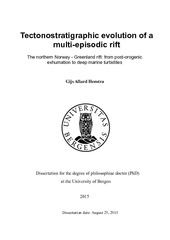| dc.contributor.author | Henstra, Gijs | eng |
| dc.date.accessioned | 2015-08-18T11:01:32Z | |
| dc.date.available | 2015-08-18T11:01:32Z | |
| dc.date.issued | 2015 | |
| dc.identifier.uri | https://hdl.handle.net/1956/10288 | |
| dc.description.abstract | The aim of this project is to improve the tectonostratigraphic understanding of the northern part of the Norwegian passive continental margin, the so-called Lofoten margin, and contribute to the wider understanding of normal fault evolution and depositional style in multiphase rift systems. Several key aspects of the evolution of the Lofoten margin have been documented and analysed using a dense database of new as well as re-processed 2-D and 3-D seismic reflection surveys: i) the nature of Palaeozoic extension in relation to post-orogenic exhumation; ii) the structural evolution of the Lofoten margin across the various rift episodes of the Mesozoic; iii) the evolving depositional environment and sedimentary systems of the North Træna Basin. In addition, sedimentological fieldwork was carried out on the conjugate margin in East Greenland, in order to provide an outcrop analogue for deep marine rift climax deposits. Large scale, extensional geometries are observed on seismic below the Base Mesozoic horizon in the North Træna Basin. In conjunction with earlier studies of exhumation in the Lofoten area, which point at a relative young age for the exhumation of deep crustal levels and describe the Lofoten Ridge as a Permian-age metamorphic core complex, these geometries are interpreted to represent the breakaway zone of a Cordilleran-style metamorphic core complex. The mechanisms behind the protracted exhumation of the Lofoten basement are discussed. The hanging wall depocentres of the Vesterdjupet Fault Zone have been mapped in detail using seismic data. A reconstruction of the structural framework per rift episode is presented. It is described how faults that had formed during the Early Triassic rift episode became selectively reactivated and linked during Late Jurassic rifting, which allowed the establishment of a single, through-going fault zone during renewed rifting towards the middle Cretaceous. Different models that could explain this fault zones characteristic zigzag plan-view geometry are discussed within the context of multiphase rifting. A seismic record of the sedimentary fill of the North Træna Basin, which forms the hanging wall to the Vesterdjupet Fault Zone, is investigated. It is demonstrated how the style of basin-fill tends to follow regional developments, but occasionally becomes strongly influenced by the progressive, stepwise establishment of the boundary fault zone over several rift episodes. These rift episodes are separated in time by long inter-rift periods, during which inactive faults become buried and the rift topography is replaced by a shelf break margin. Later rift episodes are dominated by instantaneous strain localisation, resulting in pronounced fault block rotation, which affects the routing of sedimentary systems and dictates abrupt changes in the relations among sediment supply, sea-level and subsidence. The results from the outcrop analogue study show that the majority of coarse clastic sediments of the syn-rift Wollaston Forland Group represent a continuum of deposits from a single type of gravity flow. Such gravity flows were sourced from the crystalline footwall and deposited in a wedge in the hanging wall. Several types of flow transformation that these gravity flows undergo during transport are identified and discussed. The observed fault-parallel facies variability is explained as a consequence of structural control on sediment routing from the footwall source area to the hanging wall. In the synthesis presented at the end of this thesis the results of the different papers are integrated and discussed, thus highlighting the specific aspects of a rift basin that is formed by multiple rift episodes separated by long (> 20 Myr) inter-rift periods. | en_US |
| dc.language.iso | eng | eng |
| dc.publisher | The University of Bergen | en_US |
| dc.relation.haspart | Paper I: Henstra, G. A., & Rotevatn, A. (2014). Nature of Palaeozoic extension in Lofoten, north Norwegian Continental Shelf: insights from 3‐D seismic analysis of a Cordilleran‐style metamorphic core complex. Terra Nova, 26(3), 247-252. The article is available at: <a href="http://hdl.handle.net/1956/10289" target="blank">http://hdl.handle.net/1956/10289</a> | en_US |
| dc.relation.haspart | Paper II: Henstra, G. A., Rotevatn, A., Gawthorpe, R. L., & Ravnås, R. (2015). Evolution of a major segmented normal fault during multiphase rifting: The origin of plan-view zigzag geometry. Journal of Structural Geology, 74, 45-63. The article is embargoed by the publisher and will be available after March 2017 at: <a href="http://hdl.handle.net/1956/10291" target="blank">http://hdl.handle.net/1956/10291</a>. | en_US |
| dc.relation.haspart | Paper III: Henstra, G. A., Gawthorpe, R. L., Helland-Hansen, W., Ravnås, R., Rotevatn, A. Sedimentary systems in a submerged, episodically active rift basin: a seismic case study from the Lofoten Margin, North Norway. Full text not available in BORA. | en_US |
| dc.relation.haspart | Paper IV: Henstra, G. A., Grundvåg, S-A., Johannessen, E. P., Kristensen, T. B., Midtkandal, I., Nystuen, J. P., Ravnås, R., Rotevatn, A., Surlyk, F., Sæther, T., Windelstad, J. Sediment supply and depositional processes in a submerged half graben during rift climax, with special reference to transformation of submarine gravity flows: an outcrop study from East Greenland. Full text not available in BORA. | en_US |
| dc.title | Tectonostratigraphic evolution of a multi-episodic rift. The northern Norway - Greenland rift: from post-orogenic exhumation to deep marine turbidites | en_US |
| dc.type | Doctoral thesis | |
| dc.date.updated | 2015-08-18T10:35:10Z | |
| dc.rights.holder | Copyright the Author. All rights reserved | en_US |
